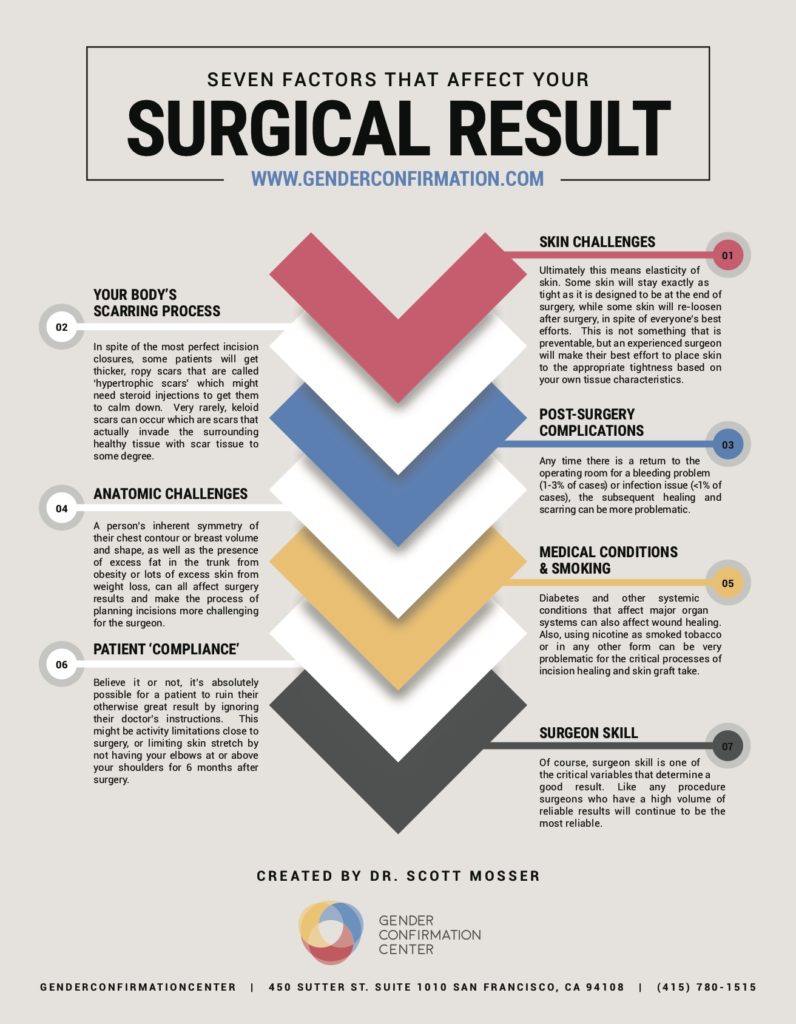7 Factors That Affect Your Top Surgery Results
Our surgeons have identified 7 main factors that can affect your top surgery outcomes. It’s important to note that this list isn’t exhaustive and other challenges or complications can arise that are not listed below. But, we hope this can give you some insight into the factors at play through the surgical and recovery process.
Skin Elasticity
Some skin will stay exactly as tight as it is intended to be at the end of surgery, while some skin will re-loosen after surgery (in spite of everyone’s best efforts). While this is not entirely preventable, an experienced surgeon will make their best effort to place skin to the appropriate tightness based on your own tissue characteristics.
One common skin challenge patients express frustration with is stretch marks. We have a regimen for our patients interested in reducing the impact of stretch marks on their surgery outcomes. Please see our page on Minimizing Stretch Marks.
The Body’s Scarring Process
In spite of perfect suturing, some patients will get thicker, ropy scars that are called ‘hypertrophic scars’. These may require steroid injections to flatten in the future. Very rarely, patients can develop keloid scars, which are scars that thicken and grow into the surrounding healthy tissue. For detailed information on chest reconstruction and scarring, click here.
Recovery Complications
Any time there is a return to the operating room for a bleeding problem (1-3% of cases) or infection issue (<1% of cases), the healing and scarring afterward can be more problematic. To learn a little more about risk and safety, click here.
Anatomical Challenges
A person’s inherent symmetry of their chest contour, chest volume/shape, and the presence of excess fat in the trunk from obesity (or lots of excess skin from weight loss), can all affect top surgery outcomes. This can make the process of planning incisions more challenging for the surgeon.
Medical Conditions and Smoking
Diabetes and other systemic conditions that affect major organ systems can also impact wound healing. Using nicotine in any form (including cigarettes, gum, chewing tobacco, etc.) can be problematic for the critical process of incision and skin graft healing. Here is some content that addresses how smoking can be detrimental.
Following Your Surgeon’s Instructions
It is possible that improperly following your surgeon’s instructions may negatively impact your surgery outcome. This might mean limiting activity and exercise close to surgery, or limiting skin stretch by not having your elbows at or above your shoulders for 3 weeks after surgery for most patients. For general post top surgery restrictions, click here.
Top Surgeon Skill
Of course, surgeon skill is one of the critical variables that determine a good outcome . Like any procedure, surgeons who have a high volume of consistent outcomes will continue to be the most reliable. Some ways to assess a top surgeon’s skill would be to ask them how many gender confirming top surgeries they’ve performed, if they’re board certified, what their complication rate is, etc.
In conclusion, there will be factors that affect your surgical outcomes that are out of your control as the patient. To limit the number of possible negative outcomes, focus on what you can control:
- Follow the post-op care instructions that your surgeon provides
- Stop smoking at least 3 weeks before top surgery and do not smoke until 3 weeks after top surgery
- Research different top surgeons so you can make an informed decision. Top surgery Facebook groups are a great place to get community feedback and see different types of top surgery outcomes
For a printable/email-friendly PDF of this content, please see the following: 7 Factors That Affect Your Top Surgery Outcomes

Sign Up For Instructions To Get a Virtual Consultation
The virtual consultation will be billed to your insurance company. We will accept the insurance reimbursement as payment in full.




